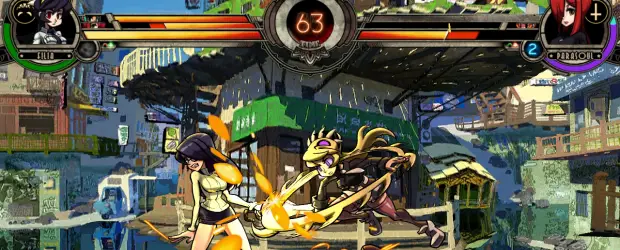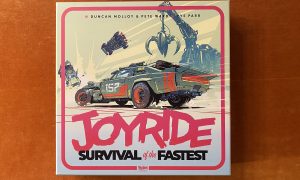
A renaissance has taken place recently in the fighting game genre. Recently Soul Calibur V and Street Fighter X Tekken came out, and Capcom has been continuously releasing updates for Street Fighter IV and Marvel vs. Capcom 3. BlazBlue: Continuum Shift Extend and King of Fighters XIII have kept 2D fighters alive. Soon we’ll see new releases in the Tekken Tag Tournament and Dead or Alive series.
On the downloadable front, we haven’t really seen much in the fighting genre. We’ve seen old games re-released like Marvel vs. Capcom 2 and the Mortal Kombat Kollection. We’ve also seen remakes like Super Street Fighter II Turbo HD Remix. Autumn Games with Reverge Labs has taken the path less traveled by releasing Skullgirls digitally on PSN and XBLA.
The story to Skullgirls is pretty thin, but you don’t usually expect much from a fighting game. An item called the Skull Heart has the ability to grant a girl one wish, as long as the girl’s heart is pure. Should there be any impurities, the wish will consume her and turn her into a Skullgirl. While it’s an odd way to get the characters together into something of a story, it’s different from the typical, “wealthiest person in the world holds tournament for top fighters.”
[singlepic id=6785 w=320 h=240 float=left]While it seems like fighters have tried to get more realistic in their approach to characters with 3D characters, Skullgirls has taken the opposite approach and has hand-drawn 2D characters and animations. The movements of each character are silky smooth. It’s so good you wonder how many hours it took to get those frames of animation drawn. This probably also accounts for the fact that there are only eight playable characters in the game.
The eight characters are some of the most creative looking characters out there. Filia may look like your typical anime schoolgirl, but her hair is possessed by a demon named Samson. Cerebella is a circus entertainer with a special hat that forms two large arms. Ms. Fortune has some cat-like qualities, but her body was cut up into several pieces so it can split apart and reassemble. However, all of the characters are women, and almost all of them have the same curvacious figures that border on the absurd like the DOA series. The protruding bosoms and panty shots throughout the game distract from the game mechanics.
The music and sound of the game is reminiscent of the jazz sounds of the speakeasy era. The bass lines move up and down, while the muted trumpet and lively keys give their own distinct melody that somehow manages to mesh with each other. The announcer sounds like he comes from the time when a deep voice mentioned the sponsors for a radio or television show before it started. The intro song, which is used for the final boss battle, has similarities to Stevie Wonder’s “Part Time Lover,” or at least that’s what constantly ran through my head after hearing it.
The most notable feature in Skullgirls is the Tutorial. While many of the concepts that are explained are almost second nature to those who are familiar with fighting games, any novice looking to understand the subtleties of the genre would be well served going through the tutorial. One annoying feature of the tutorial is the fact that you need to perform certain actions three times in a row without failing, instead of just three times during the lesson.
The Training Room has plenty of options for fighting fans. It has options for attack data, hit boxes, the hit stun bar, health, meter level, and if death is allowed. This mode is a great way to experience the inner workings of a fighting game and truly seeing the timings like how long you have before you can attack after being hit.
[singlepic id=6789 w=320 h=240 float=right]Two single-player modes are available. The Story Mode lets you choose a single character and tries to explain the motivations of that character with short conversations between fights. The Arcade Mode just has you fighting against random characters, but you select a team of up to three characters. This mode allows for the team you create to fight against a team of up to three characters. They do offset the strength of attacks so that if one character is going against three others, the three characters won’t be overpowering. It will be a bit more of a challenge due to the fact that they can do character combos while the single character team can’t. The ladders in each of these modes only consist of a few characters, so it won’t be too surprising when you reach the boss character.
While the tutorial is great for beginners, the game itself isn’t. Skullgirls wants to chew you up and spit you out. It has five difficulty levels, but don’t be too surprised if you have to turn down the difficulty from your normal skill level until you are completely accustomed to your character’s move set. You can definitely tell that this game was made for the hardcore by the hardcore.
The controls in Skullgirls mimic the Capcom low punch, medium punch, high punch, low kick, medium kick, high kick configuration. While Skullgirls is playable with a standard controller, many of the moves are difficult to pull off without having some kind of fight stick. With all of these fighting games coming out, a fight stick is becoming more and more of a necessity, even for the most casual of fans.
Skullgirls only has eight playable characters. The last games that I can remember having that few characters is the original Street Fighter II, World Heroes, and Time Bandits. Because of this, matches where the same character fights for both sides will come up fairly often, especially with three-on-three matches. If Skullgirls was a bit more newbie-friendly, this might be a great game to wean new people to the fighting genre because there are only a few characters to concentrate on. All of the characters are well-balanced though, so skill and familiarity with your character will decide the outcome instead of button-mashing.
While the characters themselves are unique, a lot of the moves are similar to other fighters. For instance, Cerebella’s Living Weapon hat looks a lot like two giant arms. Some of the moves reminded me of The Hulk in the Marvel vs. Capcom games. Filia’s slide move looks a lot like Dhalsim’s slide move. Imitation is the sincerest form of flattery, but this seems a bit overdone.
[singlepic id=6778 w=320 h=240 float=left]One of my biggest issues with the fighting game genre is the boss battle at the end. In the boss battle for Skullgirls, the hit box size is smaller than if you would be fighting against another character. The boss also has three stages. It feels like a bad episode of Dragon Ball Z where the character constantly changes form to become more powerful. While this boss battle isn’t as cheap as some of the other fighting games out there, it takes a ton of hits and lots of timed blocking to destroy the boss.
There is multiplayer options, but they are pretty sparse compared to other fighters. You have your traditional local matches, ranked quick matches, and unranked rooms that you can join or create. Those are pretty slim pickings, especially when you have replays and more advanced features available. Still, this is a downloadable title that isn’t the full price of a retail game.
In the end, Skullgirls is a difficult game to recommend. Too many fighters have come out recently to give newcomers a compelling reason to try Skullgirls other than its tutorial. While it would be a great introduction to explain fighting concept s to new players, the game difficulty isn’t friendly to newcomers. The game is definitely meant for the hardcore, but the lack of characters and features make it a hard sell. Still, for the price it has plenty to offer. If you are a hardcore fighting fan, or someone who wants to learn all of the nuances to become better at fighting games, then at least give Skullgirls a look.
While not working as a Database Administrator, Keith Schleicher has been associated with Gaming Trend since 2003. While his love of video games started with the Telestar Alpha (a pong console with four different games), he trule started playing video games when he received the ill-fated TI-99/4A. While the Speech Synthesizer seemed to be the height of gaming, eventually a 286 AT computer running at 8/12 Hz and a CGA monitor would be his outlet for a while. Eventually he’d graduate to 386, 486, Pentium, and Athlon systems, building some of those systems while doing some hardware reviews and attending Comdex. With the release of the Dreamcast that started his conversion to the console world. Since then he has acquired an NES, SNES, PS2, PS3, PSP, GBA-SP, DS, Xbox, Xbox 360, Xbox One S, Gamecube, Wii, Switch, and Oculus Quest 2. While not playing video games he enjoys bowling, reading, playing board games, listening to music, and watching movies and TV. He originally hails from Wisconsin but is now living in Michigan with his wife and sons.

See below for our list of partners and affiliates:

























